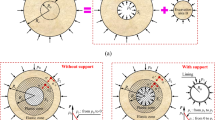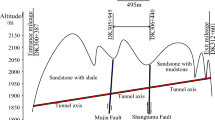Abstract
This paper presents a case study on the impact of jointed rock mass deformation on liner stability for an inclined excavation at the Bulianta Coal Mine. The tunnel was excavated by a single shield tunnel boring machine (TBM), with part of the excavation passing through a heavily jointed rock mass at great depth. Serious local instabilities occurred at one side of the liner due to highly asymmetric loading caused by large ground stresses and joint deformation. A support system with anchored cables and compressible mortar was combined with segmental lining to overcome these instabilities. With this case as a baseline, some numerical sensitivity analyses were performed to study how the ground might have responded to different combinations of support. The results show that an appropriately anchored cable system was able to limit the propagation of the asymmetric deformation of the jointed rock mass and significantly reduce the degree of anisotropy and the magnitude of the loads on the liner. The use of compressible mortar between the liner and the jointed rock mass further lowered the anisotropy of the load on the liner. There are optimum values for the rock bolt length and the compressible mortar thickness, beyond which these parameters have limited effects on the behaviour of the system. The combined effect of compressible mortar and anchor cables in promoting ground and liner stability is greater than the sum of the two individual support effects. These results clearly demonstrate that the combination of anchored cables and compressible mortar had a significant positive effect on the overall support system stability.




















Similar content being viewed by others
Abbreviations
- \(\sigma_{{\text{n}}}\) :
-
Normal stress
- \(\varphi\) :
-
Angle of internal friction
- \(\alpha\) :
-
Coefficient of multiplier
- \(\delta\) :
-
Compression ratio
- c :
-
Cohesion
- \(\sigma_{{{\text{cap}}}}\) :
-
Cap stress
- \(\Phi\) :
-
Friction angle
- D :
-
Diameter of segmental lining
- d :
-
Internal diameter of segmental lining
- E :
-
Elastic modulus
- \(K_{{\text{n}}}\) :
-
Normal stiffness
- \(K_{{\text{s}}}\) :
-
Normal stiffness
- \(J\_{\text{da}}\) :
-
Dip angle
- \(J\_{\text{dr}}\) :
-
Dip direction
- \(J\_s\) :
-
Spacing
- \(J\_l\) :
-
Joint length
- \(J\_t\) :
-
Joint thickness
- \({\text{G}}\_{\text{c}}\) :
-
Grout cohesive capacity per unit length
- \({\text{G}}\_{\text{s}}\) :
-
Grout stiffness per unit length
- \({\text{F}}\_{\text{p}}\) :
-
Pretension load
- \(\upsilon\) :
-
Poisson's ratio
- W :
-
Ring width
- R :
-
Radius of segmental lining
- \(\sigma_{{\text{t}}}\) :
-
Tensile strength
- \(\sigma_{{\text{c}}}\) :
-
Uniaxial compression strengthen
- \(\gamma\) :
-
Unit weight
- \(p_{{\text{y}}}\) :
-
Yield strength
- \(P_{{\max}}\) :
-
Maximum pressure on the liner
- \(T_{{\max}}\) :
-
Maximum thrust force of liner
- \(B_{{\max}}\) :
-
Maximum positive bending moment of liner
- \(D_{{\max}}\) :
-
Maximum deformation of liner
References
Barla G, Bonini M, Semeraro M (2011) Analysis of the behaviour of a yield-control support system in squeezing rock. Tunn Undergr Space Technol 26(1):146–154
Bayati M, Hamidi JK (2017) A case study on TBM tunnelling in fault zones and lessons learned from ground improvement. Tunn Undergr Space Technol 63:162–170
Bilgin N (2016) An appraisal of TBM performances in Turkey in difficult ground conditions and some recommendations. Tunn Undergr Space Technol 57:265–276
Bonini M, Barla G (2012) The Saint Martin La Porte access adit (Lyon–Turin Base Tunnel) revisited. Tunn Undergr Space Technol 30:38–54
Delisio A, Zhao J, Einstein HH (2013) Analysis and prediction of TBM performance in blocky rock conditions at the Lötschberg Base Tunnel. Tunn Undergr Space Technol 33:131–142
Gong QM, Yin LJ, Wu SY, Zhao J, Ting Y (2012) Rock burst and slabbing failure and its influence on TBM excavation at headrace tunnels in Jinping II hydropower station. Eng Geol 124:98–108
Itasca Consulting Group Inc (2008) UDEC User Manual. Itasca Consulting Group Inc, Minneapolis
Kang HP, Lin J, Fan MJ (2015) Investigation on support pattern of a coal mine roadway within soft rocks—a case study. Int J Coal Geol 140:31–40
Kulatilake PHSW, Shreedharan S, Sherizadeh T, Shu B, Xing Y, He P (2016) Laboratory estimation of rock joint stiffness and frictional parameters. Geotech Geol Eng 34(6):1723–1735
Lisjak A, Grasselli G, Vietor T (2014) Continuum–discontinuum analysis of failure mechanisms around unsupported circular excavations in anisotropic clay shales. Int J Rock Mech Min Sci 65:96–115
Paltrinieri E, Sandrone F, Zhao J (2016) Analysis and estimation of gripper TBM performances in highly fractured and faulted rocks. Tunn Undergr Space Technol 52:44–61
Smith JV (2016) Assessing the ability of rock masses to support block breakage at the TBM cutter face. Tunn Undergr Space Technol 57:91–98
Standard ASTM D7012 (2014) Standard test method for compressive strength and elastic moduli of intact rock core specimens under varying states of stress and temperatures. ASTM International, West Conshohocken
Sulem J, Subrin D, Monin N, Lascols J (2013) Anisotropic closure in squeezing rocks: the example of Saint-Martin-la-Porte access gallery. Rock Mech Rock Eng 46(2):231–246
Tan X, Chen W, Liu H, Chan AHC, Tian H, Meng X, Wang F, Deng X (2017) A combined supporting system based on foamed concrete and U-shaped steel for underground coal mine roadways undergoing large deformations. Tunn Undergr Space Technol 68:196–210
Vlachopoulos N, Diederichs MS (2009) Improved longitudinal displacement profiles for convergence confinement analysis of deep tunnels. Rock Mech Rock Eng 42(2):131–146
Wang SY, Sloan SW, Tang CA, Zhu WC (2012) Numerical simulation of the failure mechanism of circular tunnels in transversely isotropic rock masses. Tunn Undergr Space Technol 32:231–244
Zhao K, Janutolo M, Barla G, Chen GX (2014) 3D simulation of TBM excavation in brittle rock associated with fault zones: the Brenner exploratory tunnel case. Eng Geol 181:93–111
Zheng YL, Zhang QB, Zhao J (2016) Challenges and opportunities of using tunnel boring machines in mining. Tunn Undergr Space Technol 57:287–299
Funding
This research was supported by the National Key Research and Development Program (2016YFC0802205), the Natural Science Foundation of China (No. 51578460).
Author information
Authors and Affiliations
Corresponding author
Additional information
Publisher's Note
Springer Nature remains neutral with regard to jurisdictional claims in published maps and institutional affiliations.
Rights and permissions
About this article
Cite this article
Hu, X., He, C., Walton, G. et al. A Combined Support System Associated with the Segmental Lining in a Jointed Rock Mass: The Case of the Inclined Shaft Tunnel at the Bulianta Coal Mine. Rock Mech Rock Eng 53, 2653–2669 (2020). https://doi.org/10.1007/s00603-020-02056-9
Received:
Accepted:
Published:
Issue Date:
DOI: https://doi.org/10.1007/s00603-020-02056-9




